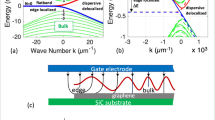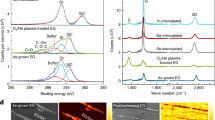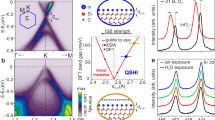Abstract
Semiconducting graphene plays an important part in graphene nanoelectronics because of the lack of an intrinsic bandgap in graphene1. In the past two decades, attempts to modify the bandgap either by quantum confinement or by chemical functionalization failed to produce viable semiconducting graphene. Here we demonstrate that semiconducting epigraphene (SEG) on single-crystal silicon carbide substrates has a band gap of 0.6 eV and room temperature mobilities exceeding 5,000 cm2 V−1 s−1, which is 10 times larger than that of silicon and 20 times larger than that of the other two-dimensional semiconductors. It is well known that when silicon evaporates from silicon carbide crystal surfaces, the carbon-rich surface crystallizes to produce graphene multilayers2. The first graphitic layer to form on the silicon-terminated face of SiC is an insulating epigraphene layer that is partially covalently bonded to the SiC surface3. Spectroscopic measurements of this buffer layer4 demonstrated semiconducting signatures4, but the mobilities of this layer were limited because of disorder5. Here we demonstrate a quasi-equilibrium annealing method that produces SEG (that is, a well-ordered buffer layer) on macroscopic atomically flat terraces. The SEG lattice is aligned with the SiC substrate. It is chemically, mechanically and thermally robust and can be patterned and seamlessly connected to semimetallic epigraphene using conventional semiconductor fabrication techniques. These essential properties make SEG suitable for nanoelectronics.
This is a preview of subscription content, access via your institution
Access options
Access Nature and 54 other Nature Portfolio journals
Get Nature+, our best-value online-access subscription
$29.99 / 30 days
cancel any time
Subscribe to this journal
Receive 51 print issues and online access
$199.00 per year
only $3.90 per issue
Buy this article
- Purchase on Springer Link
- Instant access to full article PDF
Prices may be subject to local taxes which are calculated during checkout




Similar content being viewed by others
Data availability
The authors declare that all other data supporting the findings of this study are available in the Article and its Supplementary Information and are also available from the corresponding author on request.
References
Schwierz, F., Pezoldt, J. & Granzner, R. Two-dimensional materials and their prospects in transistor electronics. Nanoscale 7, 8261–8283 (2015).
Van Bommel, A. J., Crombeen, J. E. & Van Tooren, A. LEED and Auger electron observations of the SiC(0001) surface. Surf. Sci. 48, 463–472 (1975).
Norimatsu, W. & Kusunoki, M. Growth of graphene from SiC{0001} surfaces and its mechanisms. Semicond. Sci. Technol. 29, 064009 (2014).
Nair, M. et al. Band gap opening induced by the structural periodicity in epitaxial graphene buffer layer. Nano Lett. 17, 2681–2689 (2017).
Turmaud, J.-P. Variable Range Hopping Conduction in the Epitaxial Graphene Buffer Layer on SiC(0001). Georgia Institute of Technology, PhD thesis (2018).
Chen, A., Hutchby, J., Zhirnov, V. & Bourianoff, G. (eds) Emerging Nanoelectronic Devices (Wiley, 2015).
de Heer, W. A., Berger, C. & First, P. N. Patterned thin film graphite devices and method for making same. US patent 7,015,142 B2 (2006).
Berger, C. et al. Ultrathin epitaxial graphite: 2D electron gas properties and a route toward graphene-based nanoelectronics. J. Phys. Chem. B 108, 19912–19916 (2004).
Nakada, K., Fujita, M., Dresselhaus, G. & Dresselhaus, M. S. Edge state in graphene ribbons: nanometer size effect and edge shape dependence. Phys. Rev. B 54, 17954–17961 (1996).
Das Sarma, S., Adam, S., Hwang, E. H. & Rossi, E. Electronic transport in two-dimensional graphene. Rev. Mod. Phys. 83, 407–470 (2011).
Han, M. Y., Özyilmaz, B., Zhang, Y. & Kim, P. Energy band-gap engineering of graphene nanoribbons. Phys. Rev. Lett. 98, 206805 (2007).
Stergiou, A., Cantón-Vitoria, R., Psarrou, M. N., Economopoulos, S. P. & Tagmatarchis, N. Functionalized graphene and targeted applications – highlighting the road from chemistry to applications. Prog. Mater Sci. 114, 100683 (2020).
Chhowalla, M., Jena, D. & Zhang, H. Two-dimensional semiconductors for transistors. Nat. Rev. Mater. 1, 16052 (2016).
Emtsev, K. V., Speck, F., Seyller, Th., Ley, L. & Riley, J. D. Interaction, growth, and ordering of epitaxial graphene on SiC{0001} surfaces: a comparative photoelectron spectroscopy study. Phys. Rev. B 77, 155303 (2008).
Riedl, C., Coletti, C. & Starke, U. Structural and electronic properties of epitaxial graphene on SiC(0 0 0 1): a review of growth, characterization, transfer doping and hydrogen intercalation. J. Phys. D 43, 374009 (2010).
de Heer, W. A. et al. Large area and structured epitaxial graphene produced by confinement controlled sublimation of silicon carbide. Proc. Natl Acad. Sci. USA 108, 16900–16905 (2011).
de Heer, W. A. Graphene transistor. US patent 9,171,907 B2 (2015).
Nevius, M. S. et al. Semiconducting graphene from highly ordered substrate interactions. Phys. Rev. Lett. 115, 136802 (2015).
Cheng, L., Zhang, C. & Liu, Y. Why two-dimensional semiconductors generally have low electron mobility. Phys. Rev. Lett. 125, 177701 (2020).
Emery, J. D. et al. Chemically resolved interface structure of epitaxial graphene on SiC(0001). Phys. Rev. Lett. 111, 215501 (2013).
Conrad, M. et al. Structure and evolution of semiconducting buffer graphene grown on SiC(0001). Phys. Rev. B 96, 195304 (2017).
Goler, S. et al. Revealing the atomic structure of the buffer layer between SiC(0001) and epitaxial graphene. Carbon 51, 249–254 (2013).
Tairov, Y. M. & Tsvetkov, V. F. Progress in controlling the growth of polytypic crystals. Prog. Cryst. Growth Charact. 7, 111–162 (1983).
Bao, J., Yasui, O., Norimatsu, W., Matsuda, K. & Kusunoki, M. Sequential control of step-bunching during graphene growth on SiC (0001). Appl. Phys. Lett. 109, 081602 (2016).
Honstein, G., Chatillon, C. & Baillet, F. Thermodynamic approach to the vaporization and growth phenomena of SiC ceramics. I. SiC and SiC–SiO2 mixtures under neutral conditions. J. Eur. Ceram. Soc. 32, 1117–1135 (2012).
Müller, G. & Friedrich J. in Encyclopedia of Condensed Matter Physics (eds Bassani, F. et al.) 262–274 (Elsevier, 2005).
Huang, L. et al. High-contrast SEM imaging of supported few-layer graphene for differentiating distinct layers and resolving fine features: there is plenty of room at the bottom. Small 14, 1704190 (2018).
Ferrari, A. C. et al. Raman spectrum of graphene and graphene layers. Phys. Rev. Lett. 97, 187401 (2006).
Kunc, J., Hu, Y., Palmer, J., Berger, C. & de Heer, W. A. A method to extract pure Raman spectrum of epitaxial graphene on SiC. Appl. Phys. Lett. 103, 201911 (2013).
Gammelgaard, L. et al. Graphene transport properties upon exposure to PMMA processing and heat treatments. 2D Mater. 1, 035005 (2014).
Donato, N. & Udrea, F. Static and dynamic effects of the incomplete ionization in superjunction devices. IEEE Trans. Electron Devices 65, 4469–4475 (2018).
Vallejos-Burgos, F., Coudert, F.-X. & Kaneko, K. Air separation with graphene mediated by nanowindow-rim concerted motion. Nat. Commun. 9, 1812 (2018).
Li, M. et al. Electronically engineered interface molecular superlattices: STM study of aromatic molecules on graphite. Phys. Rev. B 76, 155438 (2007).
Sul, O. et al. Reduction of hole doping of chemical vapor deposition grown graphene by photoresist selection and thermal treatment. Nanotechnology 27, 505205 (2016).
Jariwala, D. et al. Band-like transport in high mobility unencapsulated single-layer MoS2 transistors. Appl. Phys. Lett. 102, 173107 (2013).
Li, J.-T. et al. Localized tail state distribution and hopping transport in ultrathin zinc-tin-oxide thin film transistor. Appl. Phys.Lett. 110, 023504 (2017).
Chen, J. H. et al. Charged-impurity scattering in graphene. Nat. Phys. 4, 377–381 (2008).
Kittel, C. Introduction to Solid State Physics, 8th edn (2004, Wiley).
Schwierz, F. Graphene transistors. Nat. Nanotechnol. 5, 487–496 (2010).
de Heer, W. A. Patterned graphene nanoelectronics. Georgia Tech Library Archive. https://doi.org/10.35090/gatech/69985 (2022).
de Heer, W. A. The invention of graphene electronics and the physics of epitaxial graphene on silicon carbide. Phys. Scr. 2012, 014004 (2012).
Maboudian, R., Carraro, C., Senesky, D. G. & Roper, C. S. Advances in silicon carbide science and technology at the micro- and nanoscales. J. Vacuum Sci. Technol. A 31, 050805 (2013).
Schlecht, M. T. et al. An efficient terahertz rectifier on the graphene/SiC materials platform. Sci. Rep. 9, 11205 (2019).
Epping, A. et al. Insulating state in low-disorder graphene nanoribbons. Phys, Status Solidi 256, 1900269 (2019).
Prudkovskiy, V. S. et al. An epitaxial graphene platform for zero-energy edge state nanoelectronics. Nat. Commun. 13, 7814 (2022).
Briggs, N. et al. Epitaxial graphene/silicon carbide intercalation: a minireview on graphene modulation and unique 2D materials. Nanoscale 11, 15440–15447 (2019).
Gigliotti, J. et al. Highly ordered boron nitride/epigraphene epitaxial films on silicon carbide by lateral epitaxial deposition. ACS Nano 14, 12962–12971 (2020).
Ottapilakkal, V. et al. Thermal stability of thin hexagonal boron nitride grown by MOVPE on epigraphene. J. Cryst. Growth 603, 127030 (2023).
Speck, F. et al. The quasi-free-standing nature of graphene on H-saturated SiC(0001). Appl. Phys. Lett, 99, 122106 (2011).
Palmer, J. et al. Controlled epitaxial graphene growth within removable amorphous carbon corrals. Appl. Phys. Lett, 105, 023106 (2014).
Riedl, C., Coletti, C., Iwasaki, T., Zakharov, A. A. & Starke, U. Quasi-free-standing epitaxial graphene on SiC obtained by hydrogen intercalation. Phys. Rev. Lett. 103, 246804 (2009).
Acknowledgements
Most of the work reported here was performed at the Tianjin International Center for Nanoparticles and Nanosystems (TICNN), which is a research institute at the University of Tianjin campus established in 2015 by L. Ma and W. de Heer and designed by de Heer and constructed by Ma. TICNN has a comprehensive dedicated epigraphene laboratory designed to complement and coordinate with the Georgia Institute of Technology epigraphene project. de Heer was the TICNN director until 2020. At present, he serves as the scientific advisor for the epigraphene projects at the TICNN. We acknowledge the financial support from the Double First-Class Initiative of Tianjin University and from the Department of Education in China. We thank J. Li and M. Zhao for their unwavering support in establishing the TICNN centre. L.M. thanks B. von Issendorff of the University of Freiburg, Z. Jiang of the Georgia Institute of Technology and Y. Ma of the TICNN for their discussion and help. W.A.d.H. thanks GTRI for financial support, A. Juyal. for his work and C. Berger, Z. Jiang, P. First, J. Hankinson and A. Naeemi for their advice and support. We thank J. P. Turmaud for permission to use excerpts of text and figures in Supplementary Information section 3. W.A.d.H. thanks P.H. de Heer for her encouragement, patience and support.
Author information
Authors and Affiliations
Contributions
J.Z. contributed to SEG growth, transport measurements, data processing and Supplementary Information section 4. P.J. contributed to STM measurements, data processing and Supplementary Information section 4. Y.L. was involved in materials growth and characterizations, transport measurement and data processing. R.L. contributed to device fabrication, transport measurement and data processing. K.Z. was involved in material characterization, device fabrication and data processing. H.T. contributed to material characterization and device fabrication. B.B. assisted in material growth and characterization and transport measurement. L.H. was involved in material characterization and device fabrication. K.Y. contributed to material characterization and device fabrication. X.X. contributed to material growth and characterization. R.M. edited the Supplementary Information section 4. L.M. initialized, conceptualized and supervised the project at TICNN and contributed to material growth, transport measurements, data analysis, Supplementary Information section 4 and editing of the paper. W.G. and N.D. helped with data and production of Fig. 1a, Fig. 2a,c, Fig. 3e, Extended Data Fig. 1a,b, Extended Data Figs. 2,5, Extended Data Figs. 3,6 and Supplementary Information section 1. W.A.d.H. directed the Georgia Institute of Technology projects and the TICNN transport measurements, analysis of Figs. 3 and 4 and Extended Data Fig. 8e and identified and analysed the stable SEG phase and wrote the paper.
Corresponding authors
Ethics declarations
Competing interests
The authors declare no competing interests.
Peer review
Peer review information
Nature thanks Francesca Iacopi and the other, anonymous, reviewer(s) for their contribution to the peer review of this work. Peer reviewer reports are available.
Additional information
Publisher’s note Springer Nature remains neutral with regard to jurisdictional claims in published maps and institutional affiliations.
Extended data figures and tables
Extended Data Fig. 1 Face-to-face growth of SEG.
(a) Vertical furnace with improved temperature gradient control. (b) Overlapped images of the surface of a Si-face seed chip and mirror image of the corresponding C-face source chip (slightly shifted) showing identical complementary topological features, i.e., material removed from the C-face is deposited directly above it on the Si-face which demonstrates the close interaction between the two chips. (c) Approximate times to grow a buffer layer and to grow 100 nm SiC from the source chip on the seed chip where the latter is more than 10 C cooler than the former.
Extended Data Fig. 2 Si-face source to C-face seed growth.
(a) In this inverted geometry SEM images show SEG growth on the Si-face. (b) SEM of the C-face shows an irregular structure. (c) Contrast enhanced optical microscopy shows that the (0001) terraces on the Si-face are small but regular. (d) Contrast enhanced optical microscopy shows irregular step structure on the C-face which appears to be imposed by large steps (dark lines) the Si-face. Blue lines in (c) and (d) indicate the step directions of the unprocessed chips.
Extended Data Fig. 3 SEM image a single Si-face of a chip that is processed in a silicon saturated crucible showing the stability of SEG in a Si saturated environment.
(a) the surface is largely covered with narrow (0001) terraces covered with SEG (darker areas). The white areas are bare SiC. (b) zoom in of boxed area.
Extended Data Fig. 4 AFM measurement of an atomically flat SEG terrace between two approximately 100 nm high substrate steps 300 µm apart.
In a single line scan, spanning this distance, no SiC steps are detected, (these would be at least 250 pm high.) If there were substrate steps anywhere between the major steps, then this scan would have detected them. Topological 10 µm x 10 µm maps were made at three locations indicated, which did not detect any features larger than 50 pm, i.e., 5 times smaller than the minimal SiC substrate step heights, which verifies that SEG is atomically flat.
Extended Data Fig. 5 QFSG characterization.
(a) Low temperature STM of a 20 µm by 20 µm area of QFSG produced by hydrogen intercalation shows that it is defect free. (b) Raman map of a 25 µm × 25 µm area shows that it is completely covered with graphene with no bare SiC or buffer. The arrow labeled A points to a region with a I2D/IG = 3.73 (red scan) and the arrow labeled B points to a region with a I2D/IG = 1.75 (red scan). Variations of this magnitude are expected for graphene.
Extended Data Fig. 6 Transport measurements of a QFSG Hall bar.
(a) Resistivity versus temperature, (b) Charge density versus temperature (c) Mobility versus temperature. (d) Mean free path versus temperature. Note the absence of a significant temperature dependence compared with SEG (Fig. 3). Also note that at room temperature, the charge densities and the mobilities are comparable to those of SEG.
Extended Data Fig. 7 Example of a seamless SEG/QFSG junction.
The junction was produced by depositing an Al2O3 strip, 80 µm wide, and intercalating hydrogen at 700 C.
Extended Data Fig. 8 Characteristics of a SEG field effect transistor.
See also SI. Sec. 4. (a) Schematic of field effect transistor with SEG as channel. (b) Transfer characteristics (Ids-Vgs) at bias voltage of 0, 1 and 2 V. (c) Transfer curve of the device at Vds = 1 V and corresponding logarithmic plot. (d) Output characteristic curves of the device. The field effect mobility is µFET = 22 cm2 V−1 s−1. The large reduction compared with the intrinsic SEC properties is caused by scattering from the dielectric and large contact Schottky barriers. (e) Extrapolation of the linear rise of the output curves correspond well with the STS measured band gap (Fig. 2e).
Supplementary information
Supplementary Information
This file contains Supplementary Sections 1–4, including Supplementary Figs 1–18 and Supplementary Tables 1–4.
Rights and permissions
Springer Nature or its licensor (e.g. a society or other partner) holds exclusive rights to this article under a publishing agreement with the author(s) or other rightsholder(s); author self-archiving of the accepted manuscript version of this article is solely governed by the terms of such publishing agreement and applicable law.
About this article
Cite this article
Zhao, J., Ji, P., Li, Y. et al. Ultrahigh-mobility semiconducting epitaxial graphene on silicon carbide. Nature 625, 60–65 (2024). https://doi.org/10.1038/s41586-023-06811-0
Received:
Accepted:
Published:
Issue Date:
DOI: https://doi.org/10.1038/s41586-023-06811-0
Comments
By submitting a comment you agree to abide by our Terms and Community Guidelines. If you find something abusive or that does not comply with our terms or guidelines please flag it as inappropriate.



